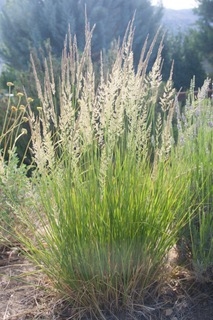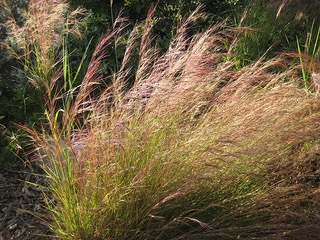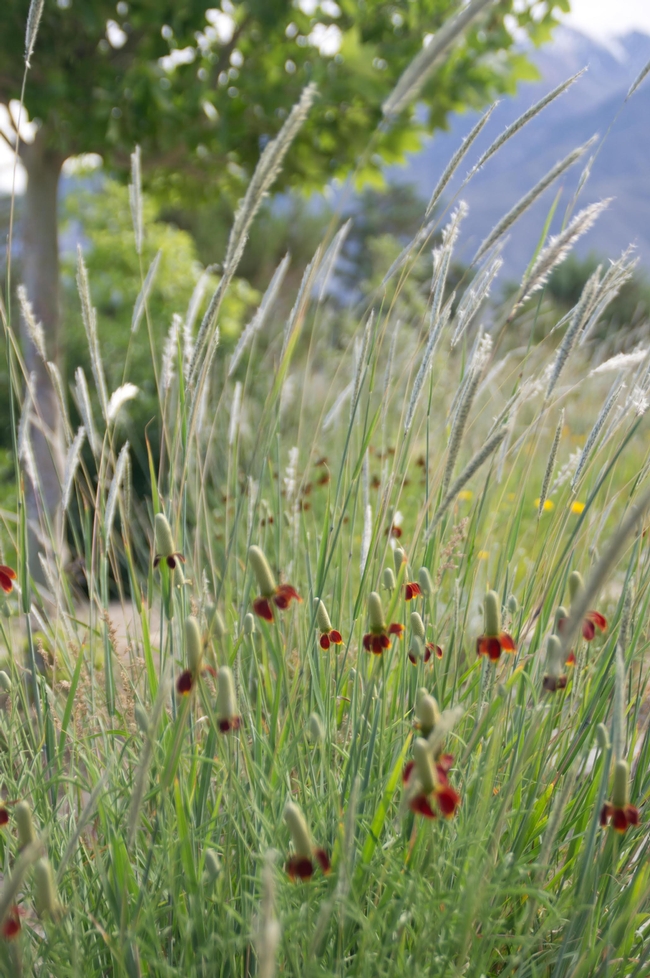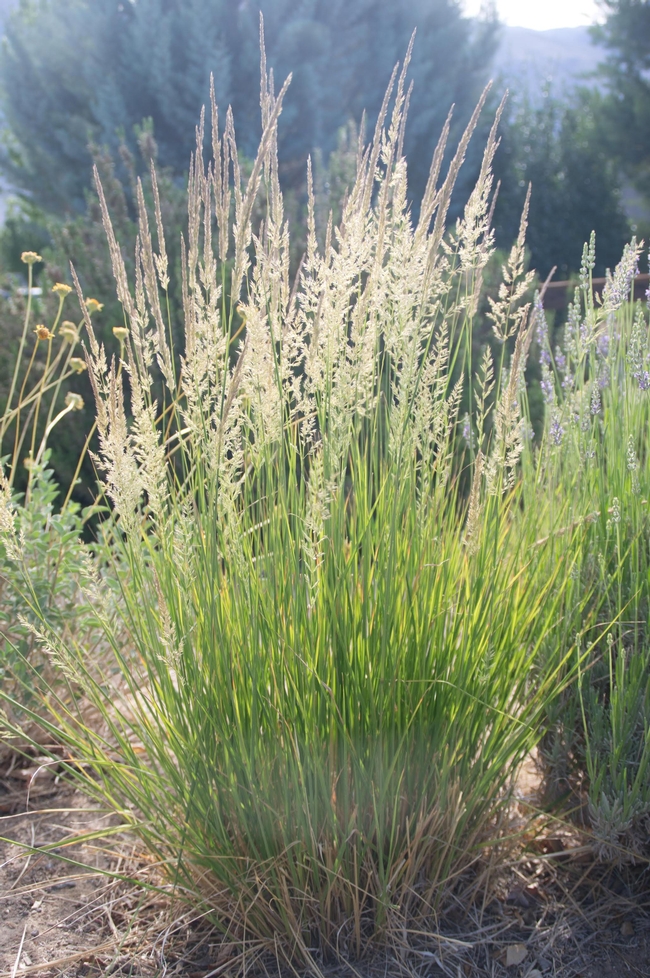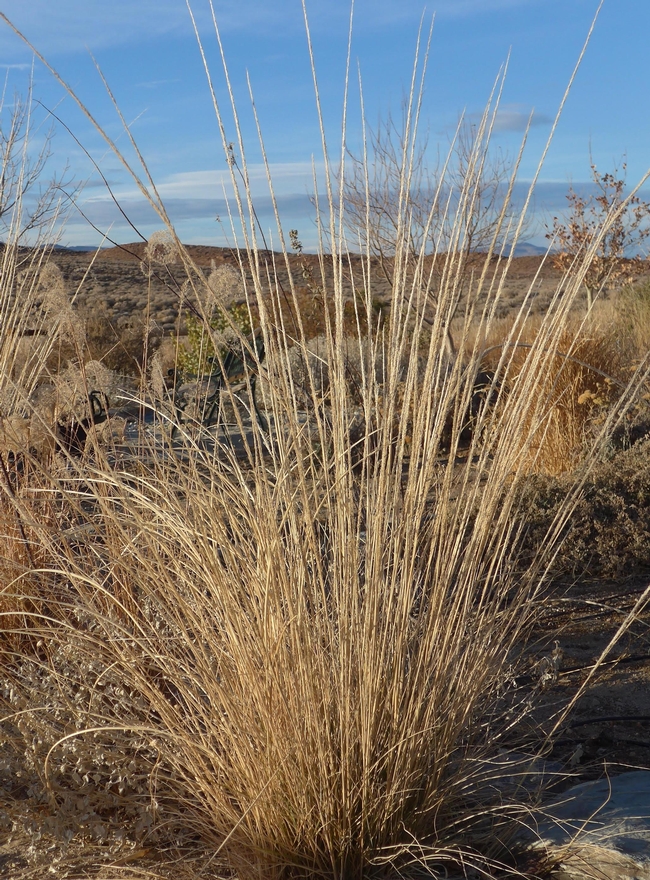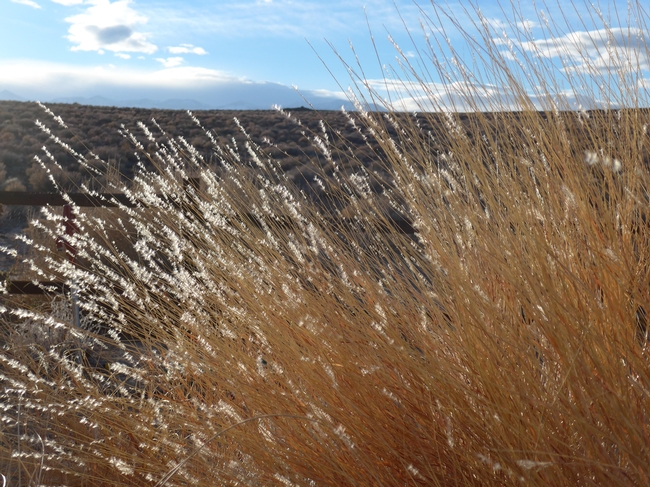- Author: Harold McDonald
I am a huge fan of ornamental grasses, and I've written before about their uses and a few of my perennial favorites, so I'll try not to cover the same ground in this post. It does bear repeating, though, that grasses are vastly underused in most gardens, and I think that's a shame, because they give you so much for very little investment of time and money. There is such variety in size, shape, and color that grasses can serve almost any role in the garden, and they provide year-round interest, from the brightest greens of early summer to yellows, oranges and even reds as the weather cools, colors that will brighten the winter landscape clear through until spring, when new growth starts again.
Below are a few suggestions for using grasses in your garden. Next time I'll share a few more of my favorites and some good websites for learning about and shopping for grasses.
Apply liberally No matter what their size, grasses look better when they are planted in groups of at least three, and more is generally better. Consider a mass planting, where the grasses are a beautiful stage upon which your flowers perform as the season progresses. Even when your Salvia greggii fades and your Gaillardia dies back to the ground, the subdued autumn shades and graceful forms of your grasses will provide cool-season interest.
Don't cut back until spring Winter is when the grasses really prove their worth in their landscape (as well as seeds for birds). Don't cut them back in the fall and lose out on all that beauty. Grasses are generally classified as cool-season or warm-season varieties, and cleaning them up varies a bit from species to species, but there's no reason to cut them back until the end of winter when new growth begins to appear.
There's one for every spot True grasses are in the family Poaceae, many of which are drought-tolerant, but there are plenty that like regular watering, and if that doesn't provide enough options for you, consider sedges or rushes, grass look-alikes that generally like moister, shadier conditions. And from the smallest blue fescue to our own towering Great Basin wild rye, there's a size for every purpose.
Shop around Local nurseries can provide many choices, but if, like me, you really get into grasses, you're always going to be on the lookout for something new! Love that ‘Morning Light' maiden grass (Miscanthus sinensis ‘Morning Light') you bought at the nursery? There are literally dozens of varieties and cultivars of that species, so there's probably another one you'd like even better that you may not be able to find easily.
Grow your own While nearly any nursery will have a few Pennisetum and Panicum grasses, you'll probably never find plants of some of my favorites like purple three-awn (Aristida purpurea) or silver beardgrass (Bothriochloa laguroides). Fortunately, these and many other grasses are easily grown from seed. That's generally a desirable trait, but given sufficient water, some grasses will reseed aggressively in your garden. Mexican feather grass (Nassella tenuissima) is one I don't recommend for that reason. Purple three-awn isn't quite as prolific, the new seedlings are easy to remove, and sometimes they pop up in a location you didn't previously recognize as just the perfect spot.
- Author: Harold Mc Donald
Last time I extolled the virtues of ornamental grasses for the garden. They exhibit such diversity in size, color and growth habit that you can use grasses in many different ways—as a tall screen, a low border, to soften the edges of walls and other hardscape elements, and to provide texture to mixed beds. Some garden designers aim to have roughly half the landscaping devoted to grasses. Here's a nice article from Fine Gardening on designing with ornamental grasses. Sunset has a handy little book—Landscaping with Ornamental Grasses—that's a good introduction to grasses with lots of photos. One more book that I have to plug (that's actually a grass pun!) is California Native Plants for the Garden, in my opinion the single best book on the subject.
As I said last time, aside from a bit of spring maintenance, ornamental grasses are extremely carefree. They do better without fertilizer, they have ba0sically no diseases or insect pests, and most are relatively drought tolerant. Of course, like any other plant, you will want to give them some extra water the first season or two to develop their root systems, but after that they can go quite a while without water, at least when compared with other garden plants.
There are so many grasses to choose from—cool season and warm season, clumpers and runners, and even some things for sale that look like grasses but aren't (e.g. rushes and sedges). I think the most important factors to consider are how much water you want to provide and what size plant you want. While I certainly don't claim to have exhaustive knowledge of all your grass choices, I do have probably a dozen species that I have grown for many seasons, and below are some of my personal favorites.
Calamagrostis acutiflora ‘Karl Foerster' feather reed grass. This is probably one of the most familiar ornamental grasses, and deservedly so. It is widely used in commercial landscaping. The Reno Convention Center is a good place to see hundreds of plants. This one is pretty hard to beat: a compact footprint for such a tall (3-5') grass, beautiful flowers that provide interest from light pink in late spring to a handsome golden tan that lasts through the fall and winter. One interesting thing to note is that the seeds of this hybrid are sterile, so no worries about unwanted babies!
Deergrass Muhlenbergia rigens This California native is regal in all ways. The plants look like giant pincushions, 5 feet tall and about as wide, and they send up dozens of spike-like flowering stems. This is about as carefree as plants come. Give it sun and space and water once a week and it will thrive. Like many natives, if you give it a gravel mulch and a bit more water, you'll probably get lots of volunteers. That's a good thing, because if you've got the space for it, a mass planting of deergrass is hard to beat!
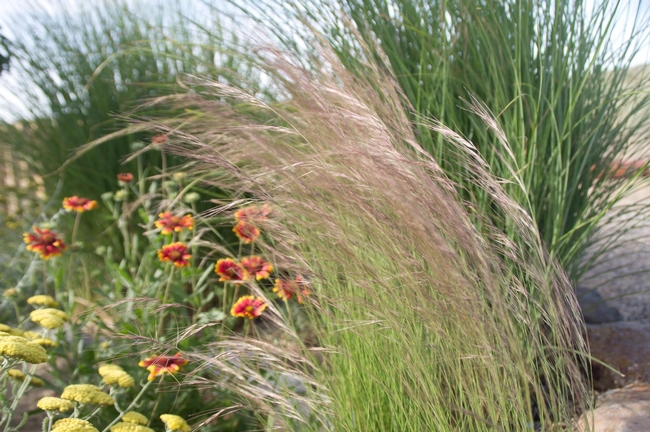
Silver beardgrass Bothriochloa laguroides ssp. torreyana (formerly Andropogon saccharoides) Yeah, the scientific name is a mouthful, but this is another one of my favorite discoveries. From what I can find, this is not truly native to California, but it is widespread in the state. This is another medium size grass, foliage about 18”, with flower spikes extending another few feet. At the end of these erect spikes are silky little puffs that are perhaps my favorite grass flowers. The leaves turn from red to purple to burnt orange in the late fall, and the flowers seem to glow in the more subdued sunlight of the cool season. The plants are a little bit floppy, so it's best to plant them in masses, where they are simply spectacular. This one can get by without much water. If you want to plant it where it gets regular water, it will be happy with that as well, but it will reseed even more readily.
Miscanthus silvergrass Dozens of cultivars have been created. One of the most widely available is ‘Morning Light,' and if you have room for it, it's a real gem. This is one that gets big (6' and more) and will need dividing every few years, so you may want to consider whether you're willing to commit to a fair bit of manual labor to maintaining this beauty.
Panicum virgatum switchgrass This is a native of the tall grass prairies of the Midwest, and is an important crop not only in native pastures and soil conservation, but also as a biomass crop and for carbon sequestration! As you might guess, it can get big—potentially 8-10', but about half that height in my yard. Despite its utility, this is one gorgeous ornamental grass as well. You can find cultivars with deep green, bluish or even purple-tinged leaves, and the airy flower heads are among the most lovely you'll find. You'll get all that and some of the best fall color around—golden, orange and flaming red.
So, where can you find these wonderful plants? The first three are pretty widely available garden plants. I've seen all of them in local nurseries. The last three are a little harder to find. Deergrass plants and seeds are available at many brick-and-mortar native plant nurseries. Theodore Payne in Sun Valley (near San Fernando) and Tree of Life Nursery between Lake Elsinore and San Juan Capistrano are two good ones in SoCal. I've never seen plants for purple three-awn and silver beardgrass available (and, believe me, I look at a lot of native plant websites!), but I got my seeds from Plants of the Southwest, a great nursery out of New Mexico. Bluestem Nursery in Canada has a great selection of reasonably-priced grasses and is a great site to visit just for information.
One last thing: most grasses are easy to grow, and sometimes this can create problems not just for the gardener, but for the surrounding habitat as well. Pampas grass has escaped gardens and become an unwelcome part of the landscape of much of the California coast. Pennisetum setaceum is a wonderful grass that has overtaken many native grasses along the roadsides of large areas of the southern California coast. Though I am not aware of any ornamental grasses that have become invasive in the high deserts of the Eastern Sierra, it's always a good idea to check locally before planting any plant—not just grasses—that might be a problem in your area. Here's a website that lists more than 200 grasses and grass-like plants that are considered invasive in some part of the US, while this one has an inventory of California invasive plants. None of the grasses I have suggested are on either list.


